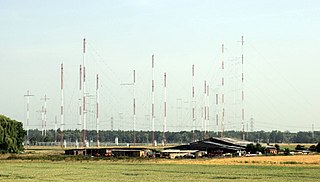International broadcasting consists of radio and television transmissions that purposefully cross international boundaries, often with then intent of allowing expatriates to remain in touch with their countries of origin as well as educate, inform, and influence residents of foreign countries. Content can range from overt propaganda and counterpropaganda to cultural content to news reports that reflect the point of view and concerns of the originating country or that seek to provide alternative information to that otherwise available as well as promote tourism and trade. In the first half of the twentieth century, international broadcasting was used by colonial empires as a means of connecting colonies with the metropole. When operated by governments or entities close to a government, international broadcasting can be a form of soft power. Less frequently, international broadcasting has been undertaken for commercial purposes by private broadcasters.

Radio Netherlands was a public radio and television network based in Hilversum, producing and transmitting programmes for international audiences outside the Netherlands from 1947 to 2012.

The Gerbrandy Tower is a radio tower in IJsselstein, the Netherlands. It is also known as Lopik tower after the nearby town. It was built in 1961.

WLW is a commercial news/talk radio station licensed to Cincinnati, Ohio. Owned by iHeartMedia, WLW is a clear-channel station, often identifying itself as “The Big One”. Its studios are located in Sycamore Township.

The Mühlacker Broadcasting Transmission Facility is a radio transmission facility near Mühlacker, Germany, first put into service on November 21, 1930. It uses two guyed steel tube masts as aerials and one guyed steel framework mast, which are insulated against ground. It has two transmission aerials for shortwave and one free standing steel framework tower for directional radio services. The shortwave transmitter was shut off on October 19, 2004. The medium wave transmitter was switched off in January 2012.

Transmitter Berlin-Britz was a broadcasting facility for medium wave, shortwave and FM on the site of a former tree nursery in Berlin-Britz. It was established in 1946 and until 1993 it was the most important transmitter of RIAS. It was used by Deutschlandradio until 4 September 2013, and was finally demolished on 18 July 2015.

The Eifel Transmitter is an FM and TV transmission facility for the German broadcasting company of SWR and is located on the Scharteberg near Kirchweiler, Germany. Until 1985, the Scharteberg transmitter used a 160 metre tall guyed mast. However this mast did not allow good reception in deep valleys, so in 1985 a new, 302 metre tall, guyed, steel framework mast was built, becoming the tallest structure of Rhineland-Palatinate. The elements of this mast were built by the firm of Hein, Lehmann AG, whilst construction work was carried out by BBS AG, Ludwigshafen. The first 20 metres of the mast were built using a small crane. The mast elements in heights between 20 and 100 metres were mounted by the aid of a car crane, while for the sections above a derrick crane was used. The new mast of Scharteberg transmitter consists of a 288 metre tall, guyed, lattice, steel structure with a square cross section, a side length of 2.1 metres and a 14 metre long GFK-cylinder on top for the UHF antenna. The total weight of the structure is 204 tons. The mast is guyed at 4 levels, 57, 123, 195 and 273 metres above ground. It is equipped with an elevator which runs up to a height of 281 metres. For aircraft warning 20 red neon lamps and two blinking lights with 1000 watt lamps are installed.

The Żórawina radio transmitter is a facility for FM transmission at Żórawina, south of Wrocław. It was established in 1932 as "Reichssender Breslau" and used as an antenna tower. Originally it was a 140-metre-tall free-standing lattice tower built of wood, on which a wire antenna was hung up. On the top of the tower there was an octagonal ring of bronze with a diameter of 10.6 metres for electrical lengthening of the antenna.

NSS Annapolis, officially known as Naval Communications Station Washington, D.C. Transmitter or NavCommStaWashingtonDC(T), was a Very Low Frequency (VLF) and High Frequency (HF) transmitter station operated by the United States Navy.

The Wavre radio transmitter is a facility for Fm, Dab+ and TV broadcasting near Wavre in Belgium. Formerly the mediumwave transmissions used a grounded 250-metre-high guyed mast. Furthermore, there was a backup mast for medium wave transmissions, which was 90 metres high. For shortwave broadcasting there were several directional antennas and a curtain antenna.
HCJB, "The Voice of the Andes", was the first radio station with daily programming in Ecuador and the first Christian missionary radio station in the world. The station was founded in 1931 by Clarence W. Jones, Reuben Larson, and D. Stuart Clark. HCJB now focuses on Ecuador with unified programming on FM at 89.3 MHz in Pichincha, at 92.5 MHz in Manabí, at 96.1 MHz in Tungurahua and Cotopaxi, at 98.3 MHz in Esmeraldas and with separate programming on AM at 690 kHz. Broadcasts in Spanish and indigenous languages on 6.05 MHz (1 kW), continue on an intermittent basis with a new solid state transmitter which in 2017 replaced an older (5 kW) transmitter. These broadcasts were not listed on the HCJB English website as of February 2016.

Radio masts and towers are typically tall structures designed to support antennas for telecommunications and broadcasting, including television. There are two main types: guyed and self-supporting structures. They are among the tallest human-made structures. Masts are often named after the broadcasting organizations that originally built them or currently use them.

KCBQ is a commercial radio station in San Diego, California. It is owned by Salem Media Group and airs a conservative talk radio format. Studios and offices are on Towne Center Drive in San Diego's University City area. The transmitter is off Moreno Avenue in Lakeside, California. By day, KCBQ operates at 50,000 watts, the maximum power for American AM stations. Because KCBQ is not a clear-channel station, it must reduce its power at night to 2900 watts to avoid interfering with Class A stations KOTV in Tulsa, Oklahoma and WWVA in Wheeling, West Virginia, both clear-channel stations. KCBQ uses a directional antenna at all times.
WRMI is a shortwave radio station broadcasting from Okeechobee, Florida, United States. WRMI is a commercial radio station that sells airtime to businesses and organizations.

CBU is a Canadian non-commercial public radio station, in Vancouver, British Columbia. It carries the programming of the CBC Radio One network. The station broadcasts on 690 AM and on 88.1 FM as CBU-2-FM. CBU's newscasts and local shows are also heard on a chain of CBC stations around the Lower Mainland.

Gartow-Höhbeck transmitter is a large facility for FM and TV transmission in Lower Saxony, Germany, situated behalf of the communities of Gartow and Höhbeck.

The Wiederau transmitter is the oldest broadcasting facility in Saxony. It is located near Wiederau, a village which is part of the municipality of Pegau, and is used for medium-wave, FM and Television broadcasting.

Curtain arrays are a class of large multielement directional radio transmitting wire antennas, used in the short-wave radio bands. They constitute a type of reflective array antenna, consisting of multiple wire dipole antennas, suspended in a vertical plane, often positioned in front of a "curtain" reflector made of a flat vertical screen of many long parallel wires. These are suspended by support wires strung between pairs of tall steel towers, reaching heights of up to 90 m high. Primarily employed for long-distance skywave transmission, they emit a beam of radio waves at a shallow angle into the sky just above the horizon, which is then reflected by the ionosphere back to Earth beyond the horizon. Curtain arrays are extensively used by international short-wave radio stations for broadcasting to large areas at transcontinental distances.
PCJJ was a pioneering shortwave radio station in the Netherlands operated by Philips Radio on behalf of Philips Laboratories, a division of Philips Electronics. It was the first shortwave radio station in Europe, and the first dedicated shortwave radio station in the world - previous stations had simulcast AM/medium wave broadcasts.
The Palatine Transmitter was the first broadcasting station in Kaiserslautern, Rhineland-Palatinate, Germany. It was built in 1926 and used an antenna, which was spun between two 60 m tall free-standing lattice towers, 130 m apart. The towers were made of wood and were the tallest wooden structures ever built in Palatine.

















